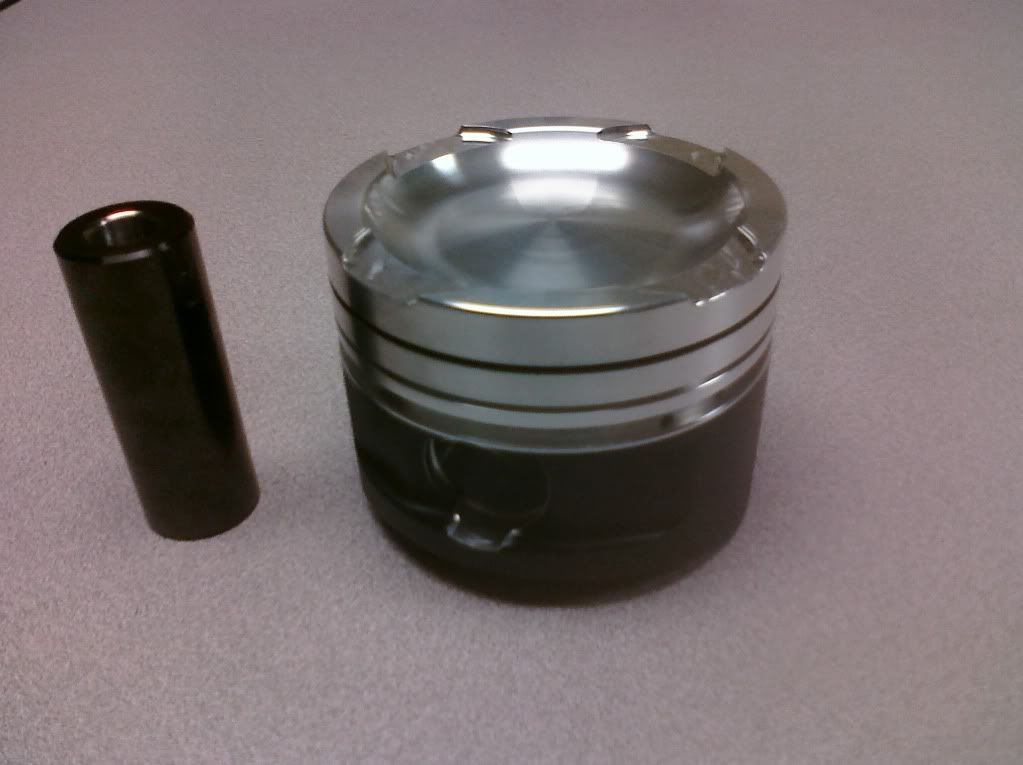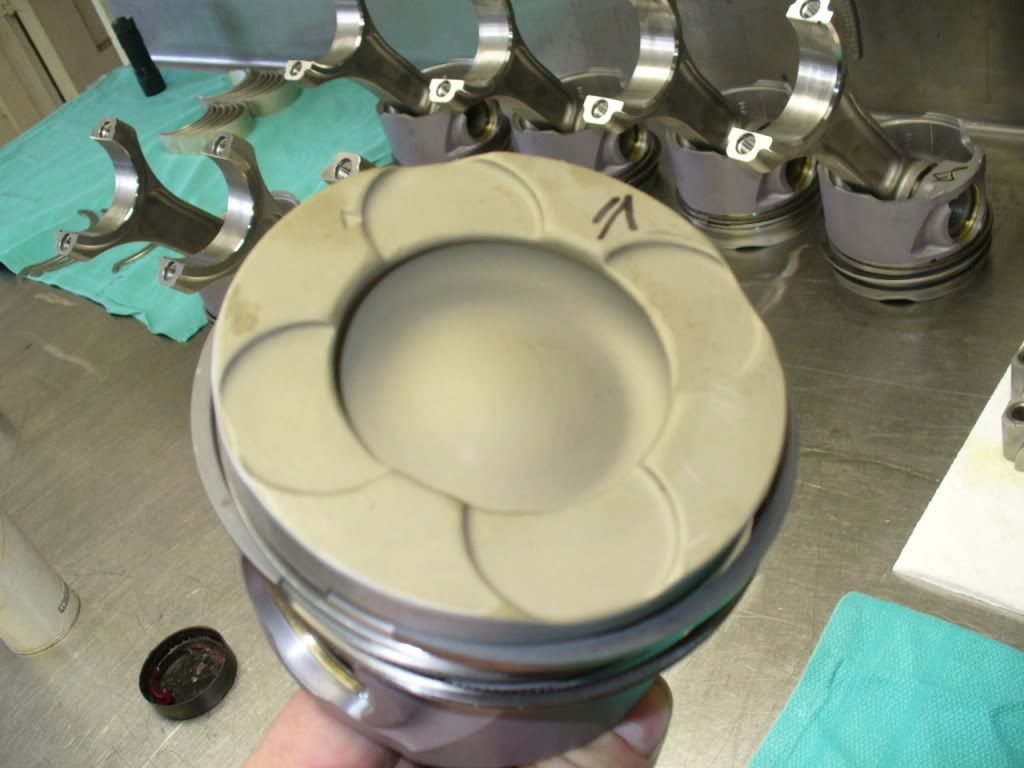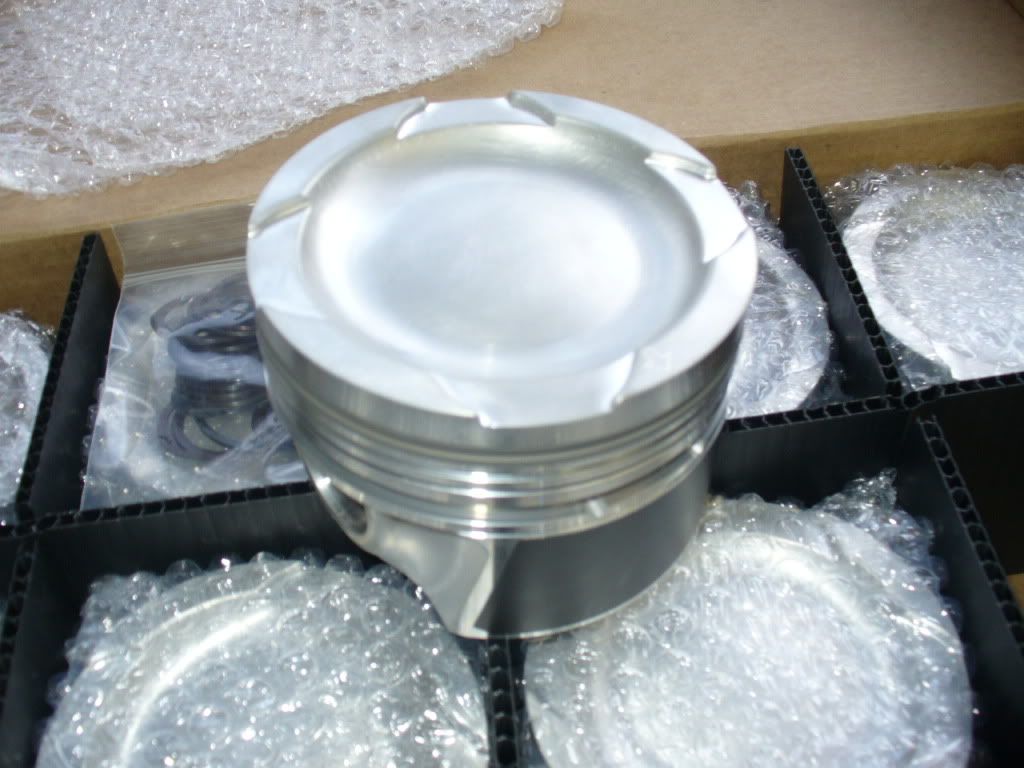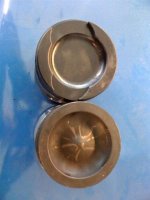You are using an out of date browser. It may not display this or other websites correctly.
You should upgrade or use an alternative browser.
You should upgrade or use an alternative browser.
What's the minimum thickness you should allow from bowl edge to piston od?
- Thread starter RonA
- Start date
Joesixpack
Pull'n it.
- Joined
- Apr 4, 2008
- Messages
- 4,118
That's my take on it, and theory of the higher failure rate of the 04.5 pistons. Do they make a QSB piston for the 6.7's....maybe it is the same piston. I duno, I like the look of the stock 6.7 bowl.
JasonCzerak
Active member
- Joined
- Aug 10, 2006
- Messages
- 14,826
It's a cummins piston part for a different series of motor.
COMP461
Comp Diesel Sponsor
- Joined
- Apr 23, 2006
- Messages
- 4,009
For power, as wide and shallow a bowl as possible, We have picked up power every time we move farther in that direction.
The tuning, in regards to timing requirements lessen as the bowl gets wider.
Remember timing is just a crutch, its fuel and chamber were perfect, and then you would need zero timing advance
You need to give the air the best chance to mix with as much air as possible, as soon as possible.
As this happens the flame front propagation speed increases, and requites less timing.
I have 3 sets of billet pistons 4.250 bore in process now and the bowl is just like this piston

I have pistons in the 6.7 bore almost ready to offer the public, in both 4.880 , and 4.720 stroke
this is the close bowl , and the second is the open bowl, the timing requirements we dramaticaly different between the two engine


The tuning, in regards to timing requirements lessen as the bowl gets wider.
Remember timing is just a crutch, its fuel and chamber were perfect, and then you would need zero timing advance
You need to give the air the best chance to mix with as much air as possible, as soon as possible.
As this happens the flame front propagation speed increases, and requites less timing.
I have 3 sets of billet pistons 4.250 bore in process now and the bowl is just like this piston

I have pistons in the 6.7 bore almost ready to offer the public, in both 4.880 , and 4.720 stroke
this is the close bowl , and the second is the open bowl, the timing requirements we dramaticaly different between the two engine


RonA
Active member
- Joined
- Feb 26, 2008
- Messages
- 11,080
In the past when I have had aluminum parts anodized, I was not allowed to have any thread inserts or non-aluminum parts attached. What type of coatings are available for the top of the piston, do they help, and can they be applied to the Cummins piston with the steel insert for the top ring? Also, how long do the coatings last?
BigDamnCummins
New member
- Joined
- Jan 31, 2010
- Messages
- 110
Hey Greg is the top piston a Ross or a Diamond?
paulb
New member
- Joined
- Jul 14, 2006
- Messages
- 1,673
Here is a stock 05 piston that has both the top and sides coated:

The coating was done by Swain Tech Coatings. As far as the durability, it seems to depend on who does them.
Paul

The coating was done by Swain Tech Coatings. As far as the durability, it seems to depend on who does them.
Paul
Smokem
Turbler
- Joined
- May 10, 2006
- Messages
- 5,565
That bowl design is asking for failure, even if the jet hits the wall, your still going to have the flame reach the crown. Run a tight pattern and things will get worse, Cummins went back on that design after investing much time on it, for a reason.
COMP461
Comp Diesel Sponsor
- Joined
- Apr 23, 2006
- Messages
- 4,009
Hey Greg is the top piston a Ross or a Diamond?
neather its a JE , I have been beating the bushes , and its time that more mainstream manufactors get in to making diesel pistons .
the price is coming down.
COMP461
Comp Diesel Sponsor
- Joined
- Apr 23, 2006
- Messages
- 4,009
That bowl design is asking for failure, even if the jet hits the wall, your still going to have the flame reach the crown. Run a tight pattern and things will get worse, Cummins went back on that design after investing much time on it, for a reason.
that pistons design is a result of a lot of research , and it makes power , with less timing , I've invested a great deal in pistons research , and this is absolutly the best design, but maybe you can learn the piston enginneres somthing , do give us the results of you dyno testing , cylinder presures results and so forth
If you look there are three different piston designs I have shown, this is being as open as I can be, I’m sharing with the people on this site the results of a lot of work. Yet you continue to say it can't or want work. Show us you piston designs.
The 2.6 engine development program going on now at
Keeter Performance Engineering is the cutting edge, the power that we will give the pullers / partners, that are involved in these programs will be absolutely the best in the world.
Big bores, short strokes, advanced rocker systems, 60 mm tool steel cams, the like the diesel world has never yet seen . Light weight rotating assamblys
. The cylinder head program is the most advanced yet to come out of ZZ. The intake manifolds are going to shock the diesel community. If you want to see these advanced 24 V / CR intakes, write a check first, as many are now doing. To many people just want to copy, funny part is what they are making a poor attempt to copy is no when near the latest, competition breeds innovation.
Smokem
Turbler
- Joined
- May 10, 2006
- Messages
- 5,565
The 3rd piston design shown would control the flame better than the 1st. I'll go out on a limb and say that Cummins invested a bit more time and money on that piston design, only to drop than you have. I did also note what piston KPE used in their Z28 build.
Last edited:
5150ram
the god father
- Joined
- Nov 20, 2007
- Messages
- 405
Here is a photo of my Scheid Diesel Arias piston compared to a stock 05 cummins piston. The Arias piston was used and abused, on an engine dyno the dyno operator held the engine at 900+ hp until the exhaust probes melted off and went through the turbo. The data logger stopped at 2000 degrees. I think the wide shallow bowl works well.
Attachments
COMP461
Comp Diesel Sponsor
- Joined
- Apr 23, 2006
- Messages
- 4,009
But they were looking for emissions as well, and I believe that part of the closed bowl design was for a passive EGR . The third design is the best we have run so far the top piston is a extreme RPM design for my Dragster. This is a piston that will run from 4500 to 6000, and never be loaded under that.
There is a lot to share here, and we have a lot of development to achieve. Just think people were laughing at my wanting to port heads, and saying it didn't make a difference 5 years ago, and people are just now beginning to understand that a cam can be the best possible bang for your buck, of anything you can do to a diesel. I have ground over 700 cams in the last few years, and this is just the beginning
There is a lot to share here, and we have a lot of development to achieve. Just think people were laughing at my wanting to port heads, and saying it didn't make a difference 5 years ago, and people are just now beginning to understand that a cam can be the best possible bang for your buck, of anything you can do to a diesel. I have ground over 700 cams in the last few years, and this is just the beginning
roachie
Taco Master
- Joined
- Nov 2, 2007
- Messages
- 11,133
Big bores, short strokes, advanced rocker systems, 60 mm tool steel cams, the like the diesel world has never yet seen . Light weight rotating assamblys
I just wanted people to read that again.
COMP461
Comp Diesel Sponsor
- Joined
- Apr 23, 2006
- Messages
- 4,009
A wide and shallow bowl is not the issue, the wall design is what controls the flame, if you don't control the flame, you cannot control the failure rate.
I believe that the way to solve the problem is to control the fuel. Lean is mean, and over fueling predicates the damage that most are speaking of.
The problem is that with a mechanical Pump, you cannot control timing; the timing is an average of what the engine really needs. A true timing curve is necessary so that you can spool the turbo charger at lower RPMS without having to resort to massive over fueling.
I see no way that a mechanical pump with be able to even get close, once people start shedding the parts that were designed for mechanical pump injection.
Just as the latest manifold, is absolutely necessary to the cam designs now going in to these engines.
Pistons in the 2.6 class will get lighter. I am moving to use a Dmax wrist pin and Dmax rod journal, to shorten the stroke on the crank. This shorter stroke will allow a longer rod, and help in rod to stroke ratio.
The Dmax has a short stroke and work really well, I am going even shorter on this as well, and for a LSR project looking at a 3.00 stroke crank in the Dmax.
One thing to think about, if you can’t feed the motor enough air, then makes the motor smaller. This will allow you to
COMP461
Comp Diesel Sponsor
- Joined
- Apr 23, 2006
- Messages
- 4,009
I just wanted people to read that again.
set this in stone.,
I ran in this this 6 years ago on cylinder head porting . People ware telling me that it was silly to port heads
kjpcummins
New member
- Joined
- Feb 15, 2009
- Messages
- 2,322
You keep talking about this 2.6 engine program. What do you consider to be a competitive size turbo for the 2.6 class. Maybe instead of trying to make all these new products you should fix the problems and failures with your current ones.
RonA
Active member
- Joined
- Feb 26, 2008
- Messages
- 11,080
A wide and shallow bowl is not the issue, the wall design is what controls the flame, if you don't control the flame, you cannot control the failure rate.
Buy control the flame do you mean that you want the center point of the corner radius to be below the top of the piston.

